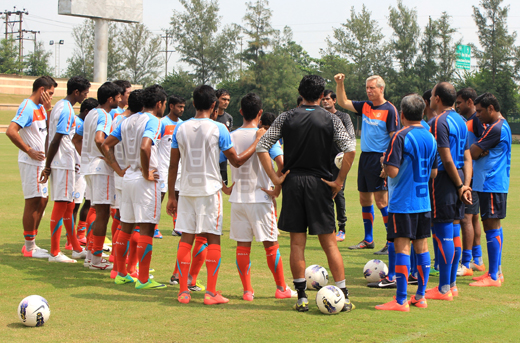Football scores at the box office in cricket-mad India
By Andrew Buncombe in Delhi
Monday, 7 March 2011
Could a new film about one of India’s most remarkable sporting encounters help to spread the popularity of football in a country renowned for its obsession with cricket?
One hundred years ago, a team of barefoot Indians from the city of Kolkata defeated a properly equipped squad of British soldiers from the East Yorkshire Regiment and won a national cup. Popular belief – though not the historical record – has it that such was the anger and embarrassment felt by the defeated British establishment that it was the final straw that made them decide to shift the imperial capital to Delhi.
Now, after five years of work by first-time director Arun Roy, a film about the football match between the regimental team and Kolkata side Mohun Bagan has been released. Already it has been showing to packed houses in West Bengal and the production team is currently finishing work to dub a soundtrack into Hindi. Roy’s hope is that when audiences in other parts of the country go to see Egaro, or “The Eleven”, people will be so inspired by the Indian team’s 2-1 victory over the dastardly British that they will become fans of the game.
The popularity of football has steadily been growing in India, especially among the urban middle classes, who often follow teams from Europe and the English Premier League. One recent report said research by India’s TAM Media had found that between 2005 and 2010, the viewing interest in football increased by 60 per cent and advertising volumes doubled. The same research suggested urban India now had 120 million cricket viewers and 83 million who watched football.
Along with Kerala and the north-east of India, West Bengal is one of the places where football has always had a popularity that matched cricket’s, and Mohun Bagan has always had one of the most loyal and vociferous of followings. Established in 1889, it is one of the oldest teams in Asia and draws its support from across the state of West Bengal.
Today, its fiercest rivals are East Bengal, who are also based in Kolkata. But the team’s most famous victory was that over the British regiment to secure the Indian Football Association (IFA) Shield. Of its players that day, only one had football boots. “Every fan of Mohun Bagan knows about this game. It was a moment in history,” said Saikat Bose, a member of the official supporters’ club.
The unexpected defeat of the British team had all the more significance given then-recent historical events. Just six years earlier, the British authorities had engineered the deeply unpopular partition of Bengal into east and west. In 1908, the British had executed an 18-year-old revolutionary, Khudiram Bose, for his role in a failed assassination attempt of a local magistrate.
For a people angry and frustrated, the football match was seen as both an actual and symbolic victory. Kausik Bandopadhyay, who teaches history at North Bengal University and is an expert on the social history of Bengali football, told Trans World Features: “It is clear from reports that when Mohun Bagan entered the final of the IFA Shield, signs of a great mass awakening were visible.”
Priyanka Roy’s great-great-grandfather Sibdas Bhaduri captained the team on that historic day. Speaking last night from Kolkata, she said: “I’ve not seen it yet but my mother has and she loved it. She never knew him, but she has told me all about him and his playing skills.”
VIA: The Independent (UK)










thanks. I digged it out and thought would be great to share as I am also a Mohun Bagan fan.
Fascinating report…just loved it….Long live Mohun Bagan……